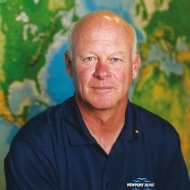Erik Larsen is executive vice president and Senior Golf Course Architect for Arnold Palmer Course Design Company. He  serves on the executive board of the American Society of Golf Course Architects. He manages the company for Mr. Palmer and is completely involved with each project from contract negotiation to construction completion. Since joining the Orlando, Florida-based firm in 1983, Larsen has been involved in the design of more than a hundred golf courses worldwide. His list of new layouts includes Deacon’s Lodge in Brainard, Minnesota; Running Y Ranch in Klamath Falls, Oregon; Spencer T. Olin Community Golf Course in Alton, Illinois; and Links at Kuilima in Oahu, Hawaii.
serves on the executive board of the American Society of Golf Course Architects. He manages the company for Mr. Palmer and is completely involved with each project from contract negotiation to construction completion. Since joining the Orlando, Florida-based firm in 1983, Larsen has been involved in the design of more than a hundred golf courses worldwide. His list of new layouts includes Deacon’s Lodge in Brainard, Minnesota; Running Y Ranch in Klamath Falls, Oregon; Spencer T. Olin Community Golf Course in Alton, Illinois; and Links at Kuilima in Oahu, Hawaii.
Arnold Palmer stared at me, and his baleful glare seemed to drill holes right through me. What had I done to draw his ire?
I was a thirty-one-year-old golf course architect in 1985 – my second year on staff at the Arnold Palmer Course Design Company. In those two years, I’d rarely been in the presence of “The King,” so I was thrilled to be making my first site visit with Mr. Palmer. We traveled to Kingsmill, Virginia to walk a would-be golf course and review our plans. Mr. Palmer, and Ed Seay (the co-founder of Palmer’s company), and Harry Knight, the property owner, set out on foot, plans in hand.
Mr. Palmer was engaged in what we were doing and considering my ideas. We were having a good time, getting along fine, and connecting. I was on top of the world: out in the fresh air playing in the dirt on a pretty site, creating a golf course with my hero, Arnold Palmer.
We reached what would be the ninth hole – a medium length par-3 hole played across a deep, dramatic ravine. Mr. Palmer took a long look at the ravine.
“I’d like to build a dam,” he said. “and fill that ravine with water so the hole will play as a water hole.”
I was tongue-tied. I wasn’t crazy about the thought of converting this dramatic ravine into a pond. I stammered for a moment, and then blurted out my opposition to Mr. Palmer.
“Sir, I don’t like your dam idea.”
Everyone, including Mr. Palmer, stopped in their tracks. Knight hurriedly stepped back as Palmer turned and fixed his astonished gaze on me.
“What did you say to me?” Palmer said.
I realized he thought I’d said I didn’t like his damn idea.
As Mr. Palmer stared daggers at me, he must have been wondering how a rookie on his first site visit could dare to speak to him in that manner!
Ed Seay, my direct boss, stepped in, as he always did, to smooth things out with Mr. Palmer.
“Arnold, what he’s trying to say is that Erik likes the dramatic shot over the ravine rather than the water shot. Plus, this is probably an environmentally sensitive wetland area and we will not be permitted to fill it in by building a dam,” Seay said. “I’m afraid your dam idea, while inspired, won’t be possible.”
Mr. Palmer, who had never taken his eyes off of me, said, “You’d better do something about this!”
Then he grinned.
I breathed a sigh of relief and didn’t fully remove my foot from my mouth until later that evening when Mr. Palmer and I had a beer and laughed about the incident.
“You were tough,” Mr. Palmer told me. “You were sticking up for your opinion. I like that.”
Palmer must have meant what he said: twenty-two years later I am still in his employee and even running his company!
